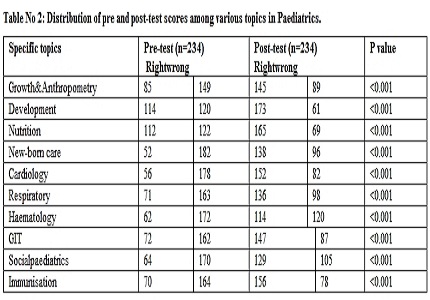Effectiveness of a structured clinical program in paediatric undergraduate training
Abstract
Objective: To assess the effectiveness of a structured training program in Paediatrics during the clinical posting of final term undergraduates.
Methods: 250final term undergraduate studentsdivided into 5 batchesparticipated in the study. They were given a pretest questionnaire on specific topics and scored for a maximum of 10. The answers were corrected by 2 different examiners. The overall scores were categorized as poor (<5) average (5to7) and good (>7). A four week structured training program of 10 topics of Paediatrics was designed. It consisted traditional formats of teaching modules like general clinics, bedside clinics, ward rounds, procedures and therapeutic discussions.To maintain continuity and reinforce learning, a topic was selected as a theme of the day and various aspects of this topic were dealt with, during the interactions in the above modules.At the end of 4 weeks the post test (same questions and format of evaluation as pretest) was administered. The data was analyzed using Gamma test and McNemer’s tests. P value of <0.05 was taken as statistically significant.
Results: In the pre-test, 77.7% scored poor and none of them had good scores. Post-test poor scores decreased to 8.9% and 23.13% had good scores. Astatistically significant improvement in the performance of the students’ in the post-test was noted as compared to the pre-test.
Conclusions: The structured training program which was used in this study resulted in significant improvement in the clinical knowledge of students.
Downloads
References
2. CleirhewL, RowneyDand Ker J. Stimulation in paediatric training. Archives of disease in childhood ,Education and practice edition. 2016 Feb; 10(1): 8-14. [PubMed]
3. Thacker N. Medical Education – the Bottle necks, President’s Page. Indian Paediatrics 2007; 44: 331-332. [PubMed]
4. LabrageG. Pre and post testing with more impact.Journal of Extension. 2007 Dec; .vol 45(6).
5. Guidelines for pre and post testing – a technical implementation guide. TIG 2:www.go2itech.org.
6. DauerL T, Kelvin JF, Horan CL and GermainJS.Evaluating the effectiveness of a radiation safety training intervention for oncology nurses: a pretest – intervention – post-test study. BMC Medical Education 2006; 6:32.
7. MuthukumarS,D’cruz S M , Anandarajan B. Introduction of Pre-Test and Post-Test enhances attentiveness toPhysiology lectures – Students’ perceptions in an Indian medical college. IJBAR 2013; 04 (05):341-344.
8. Barton R T, Dietz J T, and Holloway L. Using a Pretest-Posttest Design to Evaluate Continuing Education ProgramsProfessional Development. The International Journal of Continuing Social Work Education 2001;04: (1) 32.
9. Jose M B and Buck E, Education and training journal. Sept 2013. [PubMed]
10. Donner RS, Bickley H .Bulletin of Medical library association, 1993. July 81(3). 294 -298. [PubMed]

Copyright (c) 2016 Author (s). Published by Siddharth Health Research and Social Welfare Society

This work is licensed under a Creative Commons Attribution 4.0 International License.


 OAI - Open Archives Initiative
OAI - Open Archives Initiative


